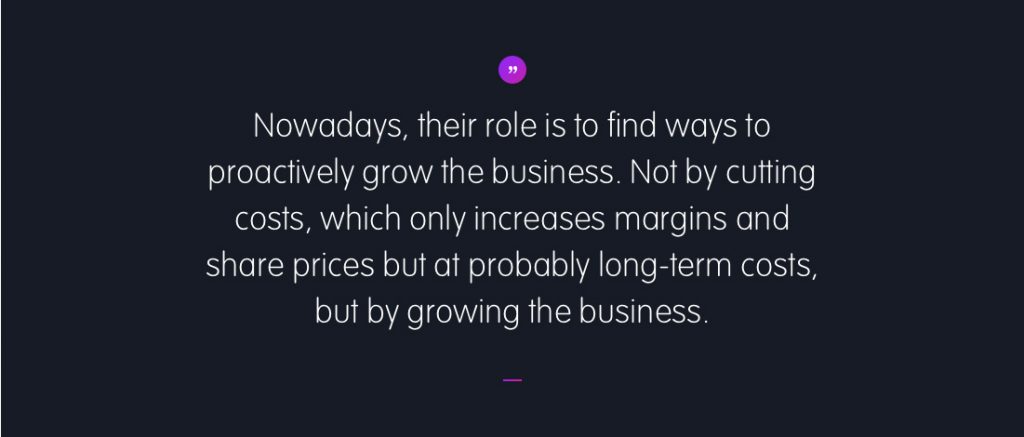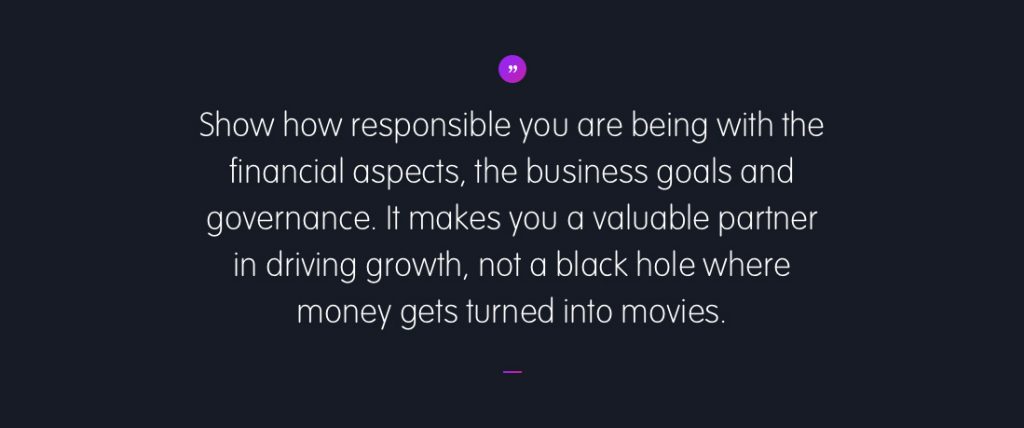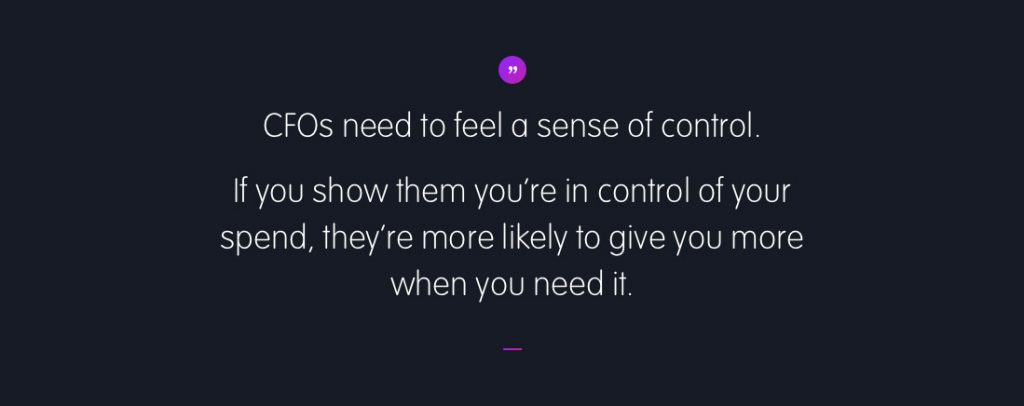In the intricate realm of business, financial decisions lay the foundation for growth and innovation. However, the task of presenting a budget proposal to a Chief Financial Officer (CFO) can be daunting.
This comprehensive guide is your ally in navigating this challenge. Building upon our insights into budgeting strategies, this blog post delves deeper into the art of convincing a CFO.
Alongside meticulous planning and data-backed justifications, discover additional indispensable techniques to articulate your budget’s value proposition. Join us on this journey to bridge the gap between visionary plans and fiscal responsibility, ensuring your proposals receive the green light they deserve.
Like all great campaigns, start with the customer.
The more you know your customer, the more you understand their motivators – their fears, their frustrations, their innermost desires – the more success you are likely to enjoy.
The thing to remember is, you’re trying to sell a campaign using numbers. Don’t try and win the argument playing their game, win the argument playing your game.
You’re not in the money game, you’re in the value game. You’re in the building the business game.
And this is where the field tips in your favour.
They’re not bean counters, they’re strategic growth partners.
The world of finance has gone from reactive corporate watchdog to proactive strategic partners. (Just look at the big consultancy firms.)
In this transition, they too have been entrenched in the brave new world of data and analytics – just as marketing people have.
Where you look for insights that help explain customer behaviours, they’ll look for insights that help explain economic behaviours.
This means the more rational members of your C-Suite will be looking to them for the “data stuff”.
And, while this might prick at your ego, it does give you a way to understand them and, through that, how to have them make a budget decision in your favour.
What is their role?
Their role used to be to track the money. Nowadays, their role is to find ways to proactively grow the business. Not by cutting costs, which only increases margins and share prices but at probably long-term costs, but by growing the business.
The pressure on the CFO now is not simply profits and margins, it’s long-term viability. They need people who can help them grow the business.
If you understand this, you understand your customer.

What are their goals?
And what are their goals in relation to business goals. Because you can probably draw a clear and distinct line between those goals and your goals. Start with revenue targets? New sales? New sales from existing customers or new sales from new customers? How can that help you win an argument?Retaining existing customers.
Numbers of new customers. In pure numbers. And as a percentage of total customers. Make sure your goals are their goals and make sure they know that you know. Have someone create a simple visual which shows the correlation between marketing goals and financial goals, and develop a set of metrics which will help you track progress towards both.
Have them agree your combined goals.
This will serve two purposes. It will give you a benchmark you can both agree to.
Which, in turn, gives you an internal goal for your department – finding industry benchmarks and case studies which help you tell the budget story in industry terms rather than company terms. Finance people understand the broad sweep of industry norms. Make sure you’re not getting the entire industry average – mature business make money at different rates to start-ups. Ensure the figures you’re using are from like-for-like businesses.
As the Ehrenberg bass Institute has shown, you can’t get a significant and sustainable rise in sales if you only spend the industry norm. Worse, if you spend less than the industry norm, there’s a fair chance you’ll lose market share.
Speak a common language.
Many people inside an organisation think marketing is just colouring in and drawing pictures because marketing people talk a different language and it’s easy to disparage the things you don’t understand. Start with data and metrics. Not your data. Or your metrics. Theirs. Understand their metrics. Capital investment. Net Present value. Depreciation. EBITDA.
If you absolutely must talk about impressions and share of voice, translate those to what the value of those things are – and why they have value. Developing a shared understanding of your objectives is no good unless you’re both talking the same language. Just as you need to understand the financial language that adds value, you need to help the CFO understand the value of core marketing objectives – like loyalty, cost per conversion, cost per acquisition, lifetime value, brand consideration scores, and net value.
And make sure your people understand the importance of a shared language and make sure everyone is at least conversational in finance.

Don’t tell them what matters to you, tell them what matters to them.
The details of a campaign to acquire customers are unimportant to a CFO. The acquisition of customers is important. Break it down so they hear what they need to hear. If they understand it, and it aligns with their goals, you’re more likely to get the money.
Be responsible.
The CFO wants the business to make smarter decisions that drive value for the business. Show how responsible you are being with the financial aspects, the business goals and governance. It makes you a valuable partner in driving growth, not a black hole where money gets turned into movies.
If it doesn’t measure, it doesn’t matter.
Numbers count. Find out what metrics matter to your CFO. For some it will be shareholder value – which is reflected in share price. If this is your CFO, you need to frame your discussions around creating value. How is the spend impacting the share price. You’re not just getting attention.
Your job is to make them understand this. Where is marketing creating the most value?

Break it down in terms they’ll understand.
Understand what the spend is by function in your department. How much is being spent on each product? In each market?
How much is being spent on development – creative and production spends –how much is being spent on enabling the messages – media – how much is being spent on enabling the sale – using the website as a sales tool and how effective your conversions are.
Draw a picture
Map the customer journey and show the spend per section of the journey. You know not all marketing dollars are spent on advertising. Chances are your CFO doesn’t. Help them understand how non-advertising initiatives are an investment and how much return can be attributed to each section of the journey. Make it clear what each dollar is being spent on. Representation at a trade-show is a short term boost in sales. A trade stand is a long-term investment in reputation and market presence. Understand how each of your initiatives intersect with other parts of the business.
The more you can show how the marketing budget is adding value across the organisation, the more chance you have of them having no alternative but to approve it.
Know how you fit into their idea of the business
Is it to save money? Is it to drive sales? Is it to build the customer base?
Is it short-term boosts or long-term returns? The clearer you can both understand what your core function is, the easier it is to have more complicated discussions down the track.

Be able to prove the return on your marketing spend.
Show their return in sales. CFOs understand sales because sales equals money. Get a friend in sales and go to the CFO as a team. “We need this to make that.”
Give a little, get a little.
If your budget is “just like last year, only more” you’ll probably fail. The CFO’s job will be to find more effective uses for the company’s money. They’ll know what products didn’t sell last year.
They’ll know what initiatives didn’t work last year. Sacrifice those for the greater good. You’re more likely to get more money if you’re seen to be responsible – not throwing good money after bad – and if it doesn’t work, you’ll at least have more money to put towards fewer initiatives.
Show expected returns, not just expected costs.
Most CFOs will see marketing as a spend not an investment. Ensure you can tie spend to business goals. Tie expected earnings to specific activity as precisely as you can.
Show how future success depends on immediate success.
Success breeds success. 90% of a rocket’s energy will be used at launch. The rest is just used for steering and maintaining momentum. Same with a marketing budget.
Get the numbers, get the reward.
Try binding your next year’s budget to your performance this year. It shows them you’re serious. And it commits their support.
If not your entire budget, at a minimum you should tie the performance of things you can directly measure – like demand generation, less customer churn, or handovers to sales.
Understand what function each dollar is serving.
Is your campaign about creating profit? (A retail marketing campaign.) Is it about an operational outcome? (An internal marketing campaign.) Is it about building reputation? (A brand campaign?)
Understand the terms they talk in, and frame your requests and reports in those terms not marketing mumbo-jumbo (their words, not ours!).

Be precise
Use analytics to inform marketing decisions. Benchmark your spend. Then match your business benchmarks to industry benchmarks. It gives you reasons to be believed. It gives you a measure you can be judged on. And quantitative measures give the CFO a greater measure of confidence in the project than qualitative measures.
Long-term growth is more profitable than short term boosts.
Visuals can help, especially if you want to find budget for a long-term brand campaign. Show the results of short-term boosts, and the diminishment over time of effectiveness of those efforts. And show the long-term value to the business of brand reputation – how not having to discount lines allows greater margin and a more effective spend.
Help the CFO understand the financial value of long-term and consistent emotional engagement (check out the book, “The Long and Short of It” by Binet and Field). Show how building reputation in one area (television or out-of-home campaigns) helps you harvest a greater profit in another (digital and social).
How can you show your efforts are building growth and providing returns on investment?

Build the business case.
By looking at the life of the expense, and amortising the spend over the life of the initiative, you are capitalising the expense, rather than simply costing the company money. This is especially important when you’re looking at reputational and brand building campaigns. Being able to amortise the costs over years (which is usually the time frame needed to show a return on those activities) allows you to more accurately show the impact to the bottom line of reputational work.
Understand the life of the expense and justify the spend over the life of the expense against the agreed metrics and business goals.
It will cost $1.5million over five years. Each customer, on average, is worth $52,600 over a three year relationship. We expect, based on similar campaigns run by us in regional areas, to attract 100,000 new customers. Which equates to $7.9million in net income.
Map the funnel.
Measure the process at each stage of the funnel.
Explain, clearly, how each marketing function at each stage of the funnel interacts with the other functions. This helps you map out a realistic future return based on current spending.
Show the timeline spend.
CFOs need to feel a sense of control.
If you show them you’re in control of your spend, they’re more likely to give you more when you need it.
Get a dashboard or a graph or an excel spreadsheet that shows what money has been allocated, what’s been spent, on what, what’s left, and how that will be spent.
Align that with your original plan.
Then show how the income matches the spend. If you can track and correlate it to the spend, where possible, using the metrics outlined above, customer engagement, customer acquisition, sales conversions etc.
Attribute the spend.
To a CFO, “digital marketing” is a line item.
To you, it’s an entire discipline with different cost:value equations for each product, each campaign, each region, each customer.
Don’t try and tell them everything. But help them understand how the budget will be spent, responsibly, to ensure the most effective use of the company’s budget.

It’s a simple case of performance management.
Show you’re taking their money very seriously.
Show your plan.
Detail your assumptions behind the plan.
Detail the KPIs and metrics.
Show the allocation per tactic.
Track the results.
There are software programs you can use to do this.
If you want to win friends, ask the finance people if they have a favourite and see if it works for your needs.
Find a way to give them visibility into your spend.
Not all goals are financial
If you have a need for a reputational piece, you can still win friends in finance by showing how responsibly you handle non-financial goals – like service level agreements and third-party relationship management.
If you can prove you have control and responsibility over these, the more likely you are to be believed when you ask for money for a reputational piece.
To summarise.
Talk to business goals – you’re in this together.
Couch your activity in terms they understand – speak a common language.
Agree analytics – so you’re both talking about the same data in the same way.
Show the pipeline – so the spend isn’t about marketing, it’s about sales. Prove how much value the marketing is driving into the sales funnel. Also understand where any leaks are and figure who has responsibility for that and work together to plug the holes.
Be accountable – show them where the money is going and where the money went – and how much that spend brought back in – if you say you’ll do something, prove you did it. And don’t just show them your results, sing them.
Even better, Shout.
